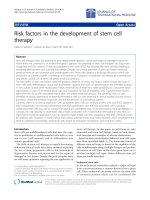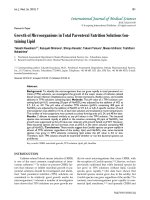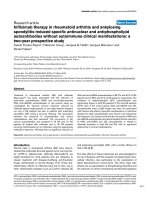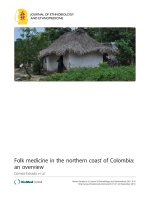Báo cáo y học: "Growth factors in lung development and disease: friends or foe?" pptx
Bạn đang xem bản rút gọn của tài liệu. Xem và tải ngay bản đầy đủ của tài liệu tại đây (239.54 KB, 4 trang )
BMP = bone morphogenetic protein; EGF = epidermal growth factor; FGF = fibroblast growth factor; TGF = transforming growth factor; VEGF =
vascular endothelial growth factor.
Available online />Introduction
Growth factors are diffusible proteins that act within a
short distance of where they are produced to induce a
variety of cellular activities through activation of diverse
signaling pathways. While their function has been tradi-
tionally associated with promotion of cell proliferation,
these factors are increasingly recognized as important
mediators of tissue interactions in the developing and
adult lung. During organogenesis they act as signaling
molecules, establishing feedback responses between
germ layers. By forming gradients along a developing
structure, growth factors help to define signaling centers
that control the behavior of neighboring cells.
In the developing lung, growth factors specify patterns of
branching, and control airway size and cell fate, among
other functions. As a general rule, growth factor signaling
mediated by tyrosine kinase receptors (such as fibroblast
growth factor [FGF], epidermal growth factor [EGF], vas-
cular endothelial growth factor [VEGF], and platelet-
derived growth factor [PDGF]) promotes cell proliferation
and differentiation, while signaling by serine-threonine
kinase receptors (transforming growth factor [TGF]β family
members, such as TGFβ1, and bone morphogenetic
protein [BMP]4) opposes these effects (reviewed in [1,2]).
In the fully developed lung, these signals are presumably
balanced to maintain cellular activities at equilibrium, so
that normal lung structure and function are preserved. The
existence of such a balance has been inferred from the
abnormal expression of these factors or their inappropriate
signaling activation in pathological lung conditions.
Growth factor imbalance thus describes a situation in
which the expression or activity of a factor predominates
over another, usually of opposing effect, within the same
system. While growth factors are key regulators of alveolar
formation, they have also been implicated in abnormal lung
remodeling that results in fibrosis and changes in the
Commentary
Growth factors in lung development and disease: friends or foe?
Tushar J Desai and Wellington V Cardoso
Pulmonary Center, Boston University School of Medicine, Boston, Massachusetts, USA
Correspondence: Wellington V Cardoso, MD, PhD, Pulmonary Center, Boston University School of Medicine, 80 East Concord Street R304, Boston,
MA 02118, USA. Tel: +1 617 638 6198; fax: +1 617 536 8093; e-mail:
Abstract
Growth factors mediate tissue interactions and regulate a variety of cellular functions that are critical
for normal lung development and homeostasis. Besides their involvement in lung pattern formation,
growth and cell differentiation during organogenesis, these factors have been also implicated in
modulating injury–repair responses of the adult lung. Altered expression of growth factors, such as
transforming growth factor β1, vascular endothelial growth factor and epidermal growth factor, and/or
their receptors, has been found in a number of pathological lung conditions. In this paper, we discuss
the dual role of these molecules in mediating beneficial feedback responses or responses that can
further damage lung integrity; we shall also discuss the basis for their prospective use as therapeutic
agents.
Keywords: airway branching, growth factors, lung development, lung injury–repair
Received: 19 June 2001
Revisions requested: 3 July 2001
Revisions received: 7 August 2001
Accepted: 9 August 2001
Published: 9 October 2001
Respir Res 2002, 3:2
This article may contain supplementary data which can only be found
online at />© 2002 BioMed Central Ltd
(Print ISSN 1465-9921; Online ISSN 1465-993X)
Page 1 of 4
(page number not for citation purposes)
Page 2 of 4
(page number not for citation purposes)
Respiratory Research Vol 3 No 1 Desai and Cardoso
architecture of the airspaces (see Fig. 1). An analysis of
their role in development and disease follows.
Growth factors in development
Growth factors are involved in virtually all aspects of lung
development. During the initial stages of lung bud morpho-
genesis and subsequent formation of the bronchial tree,
activation of FGF signaling in the epithelium by mesenchy-
mal-derived FGF10 is critical [3]. There is evidence sug-
gesting that the spatial and temporal distributions of
FGF10 in the lung determine the pattern of airway branch-
ing [4]. Control of cell proliferation and cell fate of the
nascent bud is dependent on the distal expression of
BMP4, a TGFβ superfamily member whose expression is in
turn controlled by FGF10 [5]. Additional mechanisms stim-
ulating growth of the epithelial tubules involve factors such
as EGF/TGFα, hepatocyte growth factor, and FGF7.
TGFβ1 opposes these effects. Its signaling is thought to
prevent local budding and to maintain proximal airways in
an unbranched form by suppressing epithelial cell prolifera-
tion and by promoting synthesis of extracellular matrix com-
ponents around airways [1,2]. Some factors participate in
more specific developmental programs, such as VEGF in
blood vessel formation [6] and FGF7 in type II alveolar cell
differentiation [7]. During alveolization, one of the final
steps of lung development, septation of the distal saccules
to form the definitive alveoli requires FGF and PDGF
signaling, among other factors [8,9].
Whether, and how, growth factors are implicated in the
development of specific congenital abnormalities of the
lung or in neonatal conditions, such as bronchopulmonary
dysplasia, is not well understood. Some lung abnormalities
found in human disease are also observed in genetically
altered mice in whom growth factor expression has been
disrupted. For example, transgenic mice expressing FGF7
in the distal epithelium exhibit cystic lungs reminiscent of
pulmonary cystadenomas [10]; genetic ablation of granu-
locyte macrophage-colony stimulating factor in mice
results in lungs with features of human alveolar proteinosis
[11]; pulmonary fibrosis is observed in neonatal lungs of
transgenic mice expressing TGFα in the distal epithelium
[12]. It is possible that these pathological conditions, in
part, represent the manifestation of aberrant developmen-
tal programs that lead to altered growth factor expression
or activity and generate signal imbalances.
Growth factors in lung disease
Studies in laboratory animals suggest that acute lung injury
elicits growth factor responses that trigger repair mecha-
nisms aimed at restoring lung integrity. For example, diffuse
alveolar damage induced by hyperoxia in mice is acutely
associated with increased lung levels of FGF7 and FGF2,
which promote type II cell proliferation and facilitate repair
of the damaged epithelium [13,14]. High levels of VEGF
are found in lungs of transgenic mice overexpressing inter-
leukin-13 [15]. Interestingly, accumulation of VEGF in the
alveoli appears to make these animals more resistant to
injury by hyperoxia when compared with their wild-type lit-
termates. In mice exposed to hyperoxic conditions, mortal-
ity dramatically increased when transgenics were
pretreated with an anti-VEGF neutralizing antibody [15].
Growth factor imbalances have been reported in various
lung pathological conditions, although it cannot be known
from these studies whether the imbalance is the cause or
the consequence of the disease. Imbalances have also
been described in chronic diseases of the lung in the
absence of identifiable injuries. In some cases, growth
factors mediate responses that actually amplify and propa-
gate the initial damage. These events may represent a mal-
adaptive response of the host to an original stimulus that
‘primes’ cells to subsequently respond abnormally. For
example, lung fibroblasts from patients with silicosis
treated in culture with tumor necrosis factor-α and TGFβ1
proliferate more and produce more collagen than cells
from normal subjects [16]. Patients with acute respiratory
distress syndrome that are likely to develop chronic lung
fibrosis show elevated concentrations of TGFα and pro-
collagen peptide III in bronchoalveolar lavage fluid well
before fibrosis occurs. This profibrotic milieu in the injured
lung correlates with increased mortality [17]. Similarly,
high levels of TGFβ1 are found in bronchoalveolar lavage
fluid of patients with systemic sclerosis that manifests with
lung fibrosis [18].
A model of growth factor imbalance in asthma has been
proposed by Holgate et al. [19]. They report that epithelial
Figure 1
Growth factors in development and disease. Major roles of selected
growth factors in embryonic and postnatal lung development (left) and
their potential association with lung pathological conditions (right) are
shown. BMP, bone morphogenetic protein; EGF, epidermal growth
factor; FGF, fibroblast growth factor; GM-CSF, granulocyte
macrophage-colony stimulating factor; PDGF, platelet-derived growth
factor; TGF, transforming growth factor; VEGF, vascular endothelial
growth factor.
Page 3 of 4
(page number not for citation purposes)
expression of the EGF receptor is increased in damaged
airways of normal and asthmatic subjects. However, in
asthmatics, the EGF receptor is also highly expressed in
areas where the epithelium is intact. Interestingly, in
airways of asthmatics under basal conditions, there is no
evidence of epithelial hyperproliferation despite EGF
receptor upregulation. Rather, structural changes are
found in the mesenchyme, as shown by deposition of
interstitial collagens and other matrix proteins in subbase-
ment lamina. In these patients, while EGF levels appear
normal, high levels of TGFβ1 have been detected in
airway tissue and bronchoalveolar lavage fluid [19,20].
Suppression of epithelial proliferation and stimulation of
matrix deposition suggest a predominance of the TGFβ
over the EGF effects, as if airways are being held in a
‘repair default’. The authors propose that this imbalance
may represent abnormal reactivation of mechanisms
involving epithelial–mesenchymal interactions reminiscent
of those present in the developing embryonic lung [19].
Disruption of growth factor signaling is also found in con-
ditions that affect the lung vasculature. Genetic screening
of patients with familial primary pulmonary hypertension
reveals mutations in the gene that encodes the BMP
receptor type II (BMPR-II) [21]. The mechanism by which
these mutations, in association with environmental factors,
cause the disease is obscure; BMP signaling appears to
be required to prevent uncontrolled proliferation and
abnormal remodeling of the pulmonary vasculature.
Another study in patients with pulmonary hypertension
suggests that increased local levels of VEGF and its
receptors in lung blood vessels may be involved in the for-
mation of the plexiform vascular lesions characteristic of
this disease [22]. Paradoxically, an increase in the levels of
platelet VEGF content is detected in patients undergoing
prostacyclin therapy, which is associated with a significant
improvement in their clinical status [23].
Conclusions
Given the mounting evidence implicating growth factors in
lung homeostasis and disease, could growth factor-based
therapeutic interventions prevent damage or facilitate
recovery by restoring or inducing an optimal balance of
signals in the lung? Although still preliminary, there are
experimental data that support this idea. A number of
studies have shown that administration of growth factor
prior to acute lung injury may be protective. Intratracheal
instillation of FGF7 in rats ameliorates radiation-induced
and bleomycin-induced lung injury, reduces alveolar
damage by hydrochloric acid instillation, and decreases
hyperoxia-induced mortality [24,25]. Such beneficial
effects are likely to be secondary to FGF7 induction of
alveolar type II cell proliferation and differentiation [7]. In
an experimental model of asthma induced by aerosolized
ovalbumin, pretreatment of mice with dexamethasone, a
synthetic adrenocortical steroid, fully inhibits the inflamma-
tory response and airway hyperreactivity, yet airway
remodeling is only partially inhibited [26]. Addition of EGF
to scrape-wounded bronchial epithelial cell monolayers
accelerates repair, whereas dexamethasone treatment has
no effect [27]. This raises the possibility that exogenous
EGF could be used to regenerate the injured epithelium in
conditions such as asthma and potentially prevent airway
remodeling.
It is important to point out that growth factor function is
regulated not only by modulation of ligand availability, but
also by the coordinated presence of their receptors, posi-
tive and negative signal transduction proteins, and down-
stream transcription factors in target cells. Additional
levels of complexity include modulation of function by
extracellular matrix components and interactions with
other growth factor pathways. A better understanding of
how these factors act in the lung under normal and patho-
logic conditions will provide a stronger rationale for their
use in specific therapeutic interventions and minimize the
adverse effects of less focused treatments.
Whether growth factors act as friends or foe in lung devel-
opment and lung injury depends on their presence at the
right time, in the right place and at the appropriate level.
Growth factors are necessary for normal development and
homeostasis, but it is always possible to have too much of
even a good thing.
Acknowledgement
This work was supported by a grant from NIH/NHLBI (PO1HL47049).
References
1. Warburton D, Schwarz M, Tefft D, Flores-Delgado G, Anderson
KD, Cardoso WV: The molecular basis of lung morphogene-
sis. Mech Dev 2000, 92:55-81.
2. Cardoso WV: Molecular regulation of lung development. Annu
Rev Physiol 2001, 63:471-494.
3. Sekine K, Ohuchi H, Fujiwara M, Yamasaki M, Yoshizawa T, Sato
T, Yagishita N, Matsui D, Koga Y, Itoh N, Kato S: Fgf10 is essen-
tial for limb and lung formation. Nat Genet 1999, 21:138-141.
4. Bellusci S, Grindley J, Emoto H, Itoh N, Hogan BL: Fibroblast
growth factor 10 (FGF10) and branching morphogenesis in
the embryonic mouse lung. Development 1997, 124:4867-
4878.
5. Weaver M, Dunn NR, Hogan BL: Bmp-4 and fgf10 play oppos-
ing roles during lung bud morphogenesis. Development 2000,
127:2695-2704.
6. Shalaby F, Rossant J, Yamaguchi TP: Failure of blood island for-
mation and vasculogenesis in flk-1 deficient mice. Nature
1995, 376:62-66.
7. Ulich TR, Yi ES, Longmuir K, Yin S, Biltz R, Morris CF, Housley
RM, Pierce GF: Keratinocyte growth factor is a growth factor
for type II pneumocytes in vivo. J Clin Invest 1994, 93:1298-
1306.
8. Weinstein M, Xu X, Ohyama K, Deng C-X: FGFR-3 and FGFR-4
function cooperatively to direct alveogenesis in the murine
lung. Development 1998, 125:3615-3623.
9. Bostrom H, Willetts K, Pekny M, Leveen P, Lindahl P, Hedstrand
H, Pekna M, Hellstrom M, Gebre-Medhin S, Schalling M, Nilson
M, Kurland S, Tornell J, Heath JK, Betsholtz C: PDGF-A signaling
is a critical event in lung alveolar myofibroblast development
and alveogenesis. Cell 1996, 85:863-873.
10. Simonet WS, DeRose ML, Bucay N, Nguyen HQ, Wert SE, Zhou
L, Ulich TR, Thomason A, Danilenko DM, Whitsett JA: Pulmonary
Available online />malformation in transgenic mice expressing human ker-
atinocyte growth factor in the lung. Proc Natl Acad Sci USA
1995, 92:12461-12465.
11. Stanley E, Lieschke GJ, Grail D, Metcalf D, Hodgson G, Gall JA,
Maher DW, Cebon J, Sinickas V, Dunn AR: Granulocyte/
macrophage colony stimulating factor-deficient mice show a
major pertubation of hematopoiesis but develop a character-
istic pulmonary pathology. Proc Natl Acad Sci USA 1994, 12:
5592-5596.
12. Hardie WD, Bruno MD, Huelsman KM, Iwamoto HS, Carrigan PE,
Leikauf GD, Whitsett JA, Korfhagen TR: Postnatal lung function
and morphology in transgenic mice expressing transforming
growth factor-alpha. Am J Pathol 1997, 151:1075-1083.
13. Charafeddine L, D’Angio CT, Richards JL, Stripp BR, Flkestein JN,
Orlowski CC, LoMonaco MB, Paxhia A, Ryan RM: Hyperoxia
increases keratinocyte growth factor mRNA expression in
neonatal rabbit lung. Am J Physiol 1999, 276:L105-L113.
14. Buch S, Han RNN, Liu J, Moore A, Edelson JD, Freeman BA, Post
M, Tanswell K: Basic fibroblast growth factor and growth
expression in 85% O
2
-exposed rat lung. Am J Physiol 1995,
268:L455-L464.
15. Corne J, Chupp G, Lee CG, Homer RJ, Zhu Z, Chen Q, Ma B, Du
Y, Roux F, McArdle J, Waxman AB, Elias JA: IL-13 stimulates
vascular endothelial cell growth factor and protects against
hyperoxic acute lung injury. J Clin Invest 2000, 106:783-791.
16. Arcangeli G, Cupelli V, Giuliano G: Effects of silica on human
lung fibroblast in culture. Sci Total Environ 2001, 270:135-139.
17. Madtes DK, Rubenfeld G, Klima LD, Milberg JA, Steinberg KP,
Martin TR, Raghu G, Hudson LD, Clark JG: Elevated transform-
ing growth factor-alpha levels in bronchoalveolar lavage fluid
of patients with acute respiratory distress syndrome. Am J
Respir Crit Care Med 1998, 158:424-430.
18. Ludwicka A, Ohba T, Trojanowska M, Yamakage A, Strange C,
Smith EA, Leroy EC, Sutherland S, Silver RM: Elevated levels of
platelet derived growth factor and transforming growth factor-
beta 1 in bronchoalveolar lavage fluid from patients with scle-
roderma. J Rheumatol 1995, 22:1876-1883.
19. Holgate ST, Davies DE, Lackie PM, Wilson SJ, Puddicombe SM,
Lordan JL: Epithelial–mesenchymal interactions in the patho-
genesis of asthma. J Allergy Clin Immunol 2000, 105:193-204.
20. Chu HW, Trudeau JB, Balzar S, Wenzel SE: Peripheral blood
and airway tissue expression of transforming growth factor
beta by neutrophils in asthmatic subjects and normal control
subjects. J Allergy Clin Immunol 2000, 106:1115-1123.
21. Lane KB, Machado RD, Pauciulo MW, Thomson JR, Phillips JA
3rd, Loyd JE, Nichols WC, Trembath RC: Heterozygous
germline mutations in BMPR2, encoding a TGF-beta receptor,
cause familial primary pulmonary hypertension. The Interna-
tional PPH Consortium. Nat Genet 2000, 26:81-84.
22. Hirose S, Hosoda Y, Furuya S, Otsuki T, Ikeda E: Expression of
vascular endothelial growth factor and its receptors corre-
lates closely with formation of the plexiform lesion in human
pulmonary hypertension. Pathol Int 2000, 50:472-479.
23. Eddahibi S, Humbert M, Sediame S, Chouaid C, Partovian C,
Maitre B, Teiger E, Rideau D, Simonneau G, Sitbon O, Adnot S:
Imbalance between platelet vascular endothelial growth
factor and platelet-derived growth factor in pulmonary hyper-
tension. Effect of prostacyclin therapy. Am J Respir Crit Care
Med 2000, 162:1493-1499.
24. Yi ES, Williams ST, Lee H, Malicki DM, Chin EM, Yin S, Tapley J,
Ulich TR: Keratinocyte growth factor ameliorates radiation-
and bleomycin-induced lung injury and mortality. Am J Pathol
1996, 149:1963-1970.
25. Panos RJ, Bak PM, Simonet WS, Rubin JS, Smith LJ: Intra-
tracheal instillation of keratinocyte growth factor decreases
hyperoxia-induced mortality in rats. J Clin Invest 1995, 96:
2026-2033.
26. Trifilieff A, El-Hashim A, Bertrand C: Time course of inflamma-
tory and remodeling events in a murine model of asthma:
effect of steroid treatment. Am J Physiol Lung Cell Mol Physiol
2000, 279:L1120-L1128.
27. Puddicombe SM, Polosa R, Richter A, Krishna MT, Howarth PH,
Holgate ST, Davies DE: Involvement of the epidermal growth
factor receptor in epithelial repair in asthma. FASEB J 2000,
14:1362-1374.
Respiratory Research Vol 3 No 1 Desai and Cardoso
Page 4 of 4
(page number not for citation purposes)









